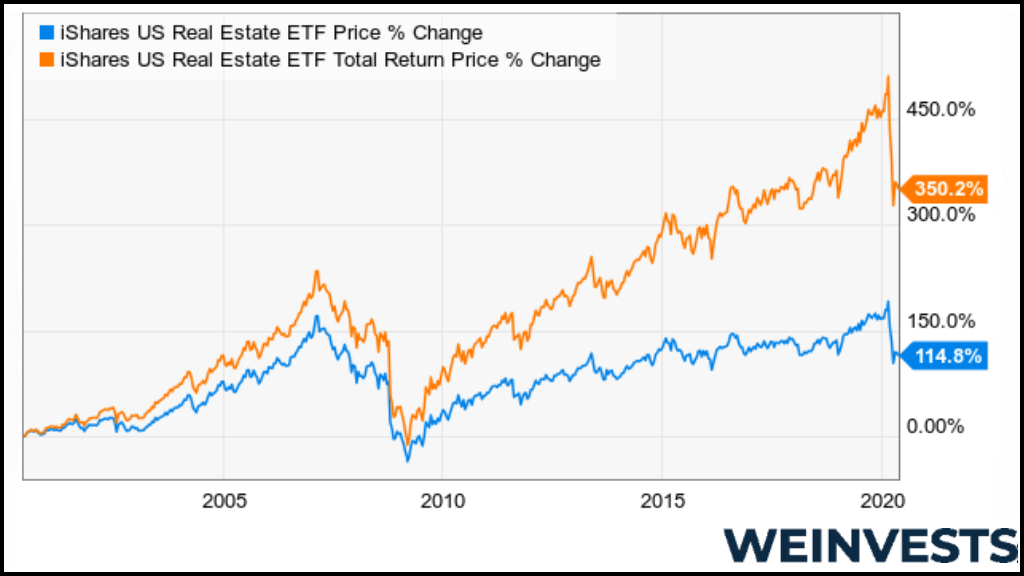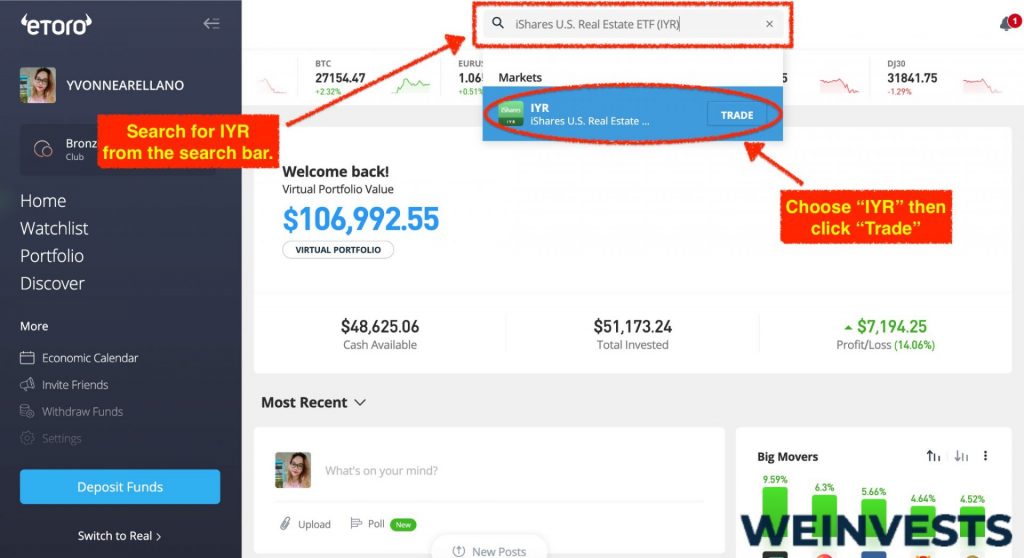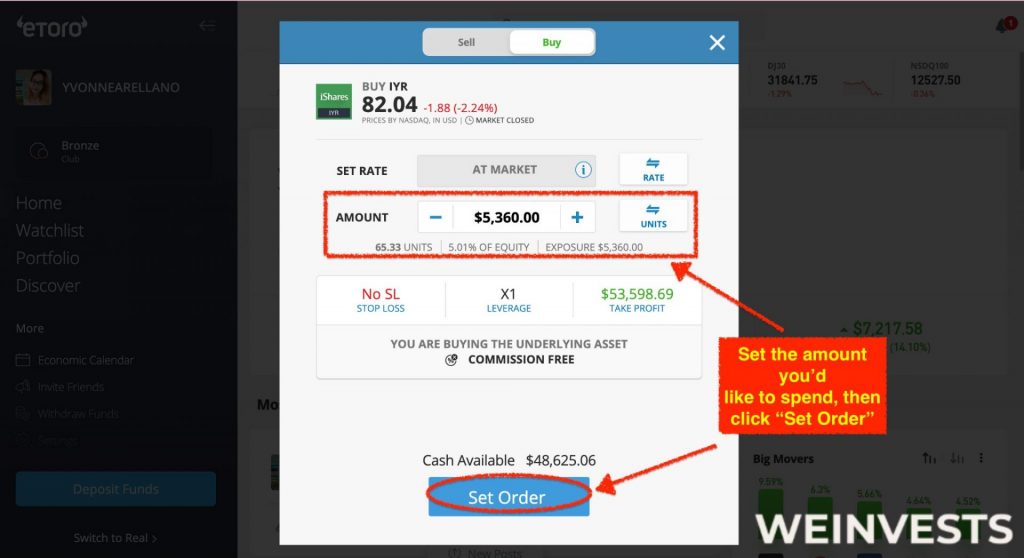This content represents the writer’s opinions and research and is not intended to be taken as financial advice. The information presented is general in nature and may not meet the specific needs of any individual or entity. It is not intended to be relied upon as a professional or financial decision-making tool.
The iShares U.S. Real Estate ETF (IYR) is an exchange-traded fund aiming to track the investment results of an index composed of U.S. real estate sector equities, namely – the Dow Jones U.S. Real Estate Capped Index. As with other ETFs, investors may acquire IYR shares through any stock exchange where it is listed and actively traded, the main one being NYSE.
Instead of cherry-picking separate Real Estate Investment Trusts (REITs) or shares of other players in the real estate sector, when purchasing the shares of IYR investors gain exposure to a pre-defined portfolio. Thus, their portfolio risk is being substantially reduced through better diversification among many holdings, meanwhile, the related costs are much lower, compared to the acquisition of many titles.
Launched in June 2000 and managed by BlackRock, IYR’s net assets currently amount to around USD 3.69 billion. This ETF also offers an annual dividend yield of 2.65%, paid out quarterly.
The purpose of this article is to analyze the key features and comparative advantages of iShares U.S. Real Estate ETF, providing potential investors with a general overview to facilitate their decision-making.
Table of Contents
Fundamentals
Essentially, similar to other ETFs, IYR is traded like a usual company stock based on its price per share which in the case of ETFs is called net asset value (NAV). It is calculated by reducing the ETF’s total liabilities from its total assets, which results in the total net assets (TNA) of the fund. Then the TNA is divided by the number of outstanding shares, arriving at the actual NAV at the open or close of the market for a given date.
The key financials of the iShares U.S. Real Estate ETF currently are as follows:
- TNA amounts to USD 3.69 billion;
- The fund is distributed among 78 holdings, primarily consisting of REITs;
- Specialized and residential REITs make over 50% of total holdings;
- Industrial and retail REITs jointly amount to nearly 25%.
- The total number of outstanding shares is 40.5 million pieces;
- NAV was USD 91.08 on the last trading day (February 16, 2023).
The fund’s expense ratio is 0.39%, so the payable annual cost is calculated based on this ratio and the volume of IYR shares the investor owns. This fee is in the average range compared to most other REIT ETFs and is charged by BlackRock as the issuer and manager of this fund for covering the related operational expenses.
The ETF started the year 2023 well, with a +9.1% year-to-date (YTD) result. Clear enough, this is driven by the overall market rebound following the previous year’s extreme drop along with the expectation of an inflationary slow-down. Provided that the key benchmark indexes have been moving in the same direction within a range of 2.5-5%, IYR’s better-than-average performance looks promising. Below are the fund’s annual results for the last five years:
Annual return in %
| 2018 | 2019 | 2020 | 2021 | 2022 | |
| Total Return | -4.29 | 28.39 | -5.39 | 38.69 | -25.46 |
| Benchmark index | -4.03 | 28.92 | -5.29 | 39.22 | -25.17 |

If we consider a longer time horizon observing the ETF’s activity since its launch, we’ll notice that the global financial crisis and the Covid-19 pandemic had the strongest negative impacts on IYR. The former drove the fund’s NAV down to its lowest point of USD 22.21 per share in March 2009, whereas the latter caused a nearly 40% decline within a month when the NAV saw a downslide from USD 94.57 to USD 76.05 in mid-March 2020. Both crushes were followed by strong V-shape recoveries, moving the IYR to new highs, including its all-time high of USD 112.41 in December 2021.
It’s important to stress that iShares U.S. Real Estate ETF is simultaneously targeting three fundamental investment goals – income generation, capital appreciation, and diversification, as per its strategy. Thus, the fund is offering reasonable diversification along with an attractive dividend, paid out of its cash inflows quarterly.
Actually, if the 20+ year performance of IYR since inception is compared with the broader market, i.e. the key indexes for the same time, then we will notice that except during the global financial crisis of 2008-2009 and the long unprecedented volatility of the last year, this ETF faced a lesser degree of turbulences in general. The fact can be comforting for many investors, especially for the ones looking for diversification of their equity-denominated portfolios combined with the additional benefit of securing a good dividend inflow for their investment.
Based on IYR’s historical performance and its above-mentioned fundamentals, it is our view that the fund will continue to remain less volatile throughout 2023, compared to the rest of the financial landscape. The markets are obviously still over-sensitive to the news on inflation and related national bank policy decisions, primarily concerning interest rate changes.
However, compared to the stronger influence on equity markets, such decisions have a limited impact on IYR and other REIT ETFs. Moreover, our forecasts conclude that the high inflation will unfortunately still last. Nevertheless, we anticipate it to gradually decline during the current fiscal year, which would be perceived as the long-expected positive news to bring some stability to the financial markets.
Investment Strategy
The core element of IYR’s investment strategy is to provide its investors with targeted access to domestic U.S. real estate REITs and stocks of promising companies engaged within that sector. In doing so, it tracks a respective broad-based index consisting of diverse titles:
- Residential REITs;
- Specialized REITs;
- Industrial REITs;
- Retail REITs;
- Healthcare REITs;
- Hotel and resort REITs.
Additionally, the fund may also add individual stocks of firms involved in research, consulting, development, management, or any other related real estate service provider to its holdings. It can invest in company shares with any capitalization, provided that those are being traded on major U.S. stock exchanges.
From its launch date in 2000, the iShares U.S. Real Estate ETF was tracking the Dow Jones U.S. Real Estate Index, however effective from January 2021 the fund follows the capped version of the same underlying index – the Dow Jones U.S. Real Estate Capped Index. Although essentially the ETF’s strategy remains unchanged, however this move implies an important adjustment, adding a capping methodology to its quarterly rebalancing exercise.
More specifically, since that change, the fund limits the weight of any single issuer to a maximum of 10% and the aggregate weight of all issuers that individually exceed 4.50% of the ETF’s weight to a maximum of 22.50% in total.
The iShares U.S. Real Estate ETF is initiated by BlackRock, as one of the champions and strongest leaders in the exchange-traded fund management space. Similar to many other index-tracking ETFs, IYR too, is managed passively as a usual index-fund approach. This allows for keeping its expense ratio at an acceptable level of 0.39% per annum.

eToro has a stellar reputation and offers a wide range of options for both beginner and professional traders. In this mini guide, we’ll walk you through the process of opening an account on eToro and investing in IYR.
Step 1: Open an Account
To get started, you’ll need to open an account on eToro. Visit the eToro homepage (https://www.etoro.com/) and click on the “Sign Up” button. You’ll be directed to the registration page, where you’ll need to provide your personal information, including your name, email address, and phone number. You’ll also need to create a username and password. After completing the registration process, you’ll receive a confirmation email to verify your account.

Step 2: Upload ID
Next, you’ll need to verify your identity by uploading a valid form of identification, such as your passport or driver’s license. This is a standard procedure to comply with regulatory requirements and ensure the safety and security of your account. To do this, navigate to the “Upload Documents” section in your eToro account and follow the on-screen instructions.

Step 3: Make a Deposit
Before you can start trading, you’ll need to deposit funds into your eToro account. You can do this by clicking on the “Deposit Funds” button on the platform. eToro supports a variety of payment methods, including credit/debit cards, bank transfers, and e-wallets such as PayPal and Neteller. Choose your preferred method and follow the on-screen instructions to complete the deposit.

Step 4: Search for IYR
Once your account is funded, you’re ready to search for iShares U.S. Real Estate ETF (IYR) on the eToro platform. To do this, simply type “IYR” into the search bar at the top of the screen. The platform will display the relevant search results, including the IYR ETF.

Step 5: Trade IYR
After locating IYR on the platform, click on the ETF to open its dedicated trading page. Here, you’ll find important information about the ETF, such as its performance, composition, and relevant news. When you’re ready to invest, click on the “Trade” button to open the trade window. Specify the amount you’d like to invest, set any stop loss or take profit levels if desired, and click “Open Trade” to complete the transaction.

Risks and Considerations
As we all know, any type of investment activity carries a set of risks, which may negatively affect the deployed capital. Hence investors must be made aware of the risks associated with acquiring shares of IYR, as a specific ETF primarily holding REITs. Although compared to classical equity or bond ETFs, the types of risks involved are quite similar, however, their impact on the REITs is somewhat different. The key risk factors associated with REITs include:
- Market risk – like stocks and bonds, REITs are traded on main stock exchanges, therefore are influenced by supply-demand forces pushing them up or down. The main causes for downward movements may include recessions, wars, natural disasters, and macroeconomic policy measures;
- Leverage risk – leverage risk may occur if any of the IYR holdings would decide to use borrowed money for investment purposes. This would incur additional expenses for that REIT, increasing the fund’s probable losses due to the underperformance of its underlying investments.
- Liquidity risk – given the nature of the underlying real estate
Indeed, before making your final decision, we suggest conducting your own research in addition to the information provided here.
Conclusion
The iShares U.S. Real Estate ETF is one of the first real estate ETFs in the USA. Launched in June 2000 and passively managed by BlackRock, the fund offers its investors exposure to domestic real estate companies and REITs, which either invest in real estate directly or provide additional services related to this sector: research and consultancy, design and construction, development and management, etc.
Shares of IYR can be traded like regular stocks via online brokerage platforms like eToro for instance. The benefits of adding this title to equity or bond-denominated portfolios would be that it will provide an extra layer of diversification, meanwhile providing a stable long-term cash flow in form of quarterly dividend payments distributed to investors.
Even though the investment in IYR carries the risks described above, this index fund is quite well-diversified among various types of real estate investment trusts and regions within the USA. It’s currently holding 78 different REITs and company stocks altogether, thus it’d be a relevant choice for investors targeting medium to long-term income generation and better diversification across various asset classes, beyond stocks and bonds.
Frequently Asked Questions
There are different types of risks involved in acquisitions of real estate investment trust ETFs, the main ones being – the market, liquidity, and leverage risks. Therefore, any investor interested in purchasing shares of such ETFs should pay due attention to analyzing those for making sure the subject investment instrument matches her/his risk appetite.
Does IYR pay a dividend and if so, what is the current yield?
Yes, this index fund is paying a good dividend with a quarterly frequency. As of end-January 2023, this ETF’s annual dividend yield is estimated to be 2.65%. The next distribution to investors will take place on March 23, 2023.
WeInvests is a financial portal-based research agency. We do our utmost best to offer reliable and unbiased information about crypto, finance, trading and stocks. However, we do not offer financial advice and users should always carry out their own research.
Read More







